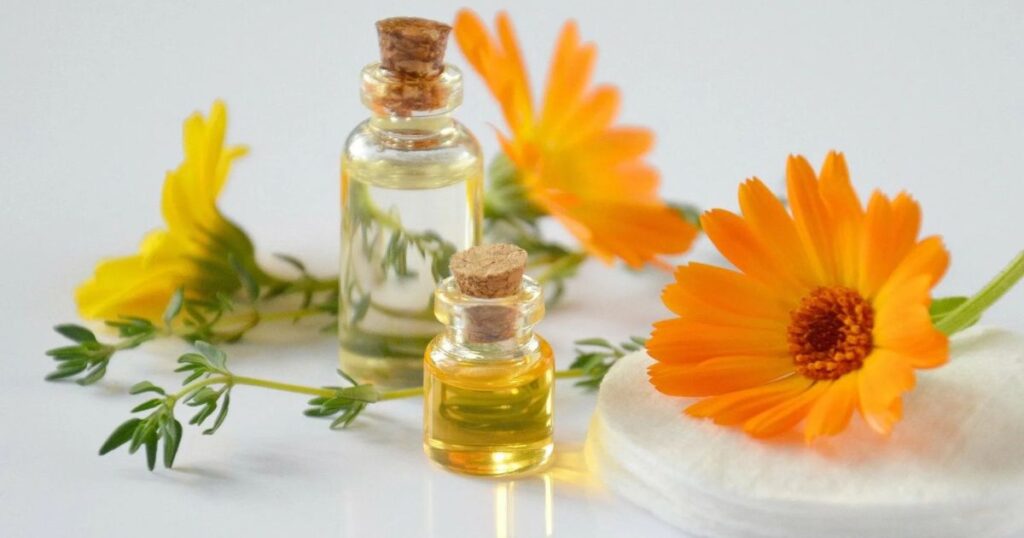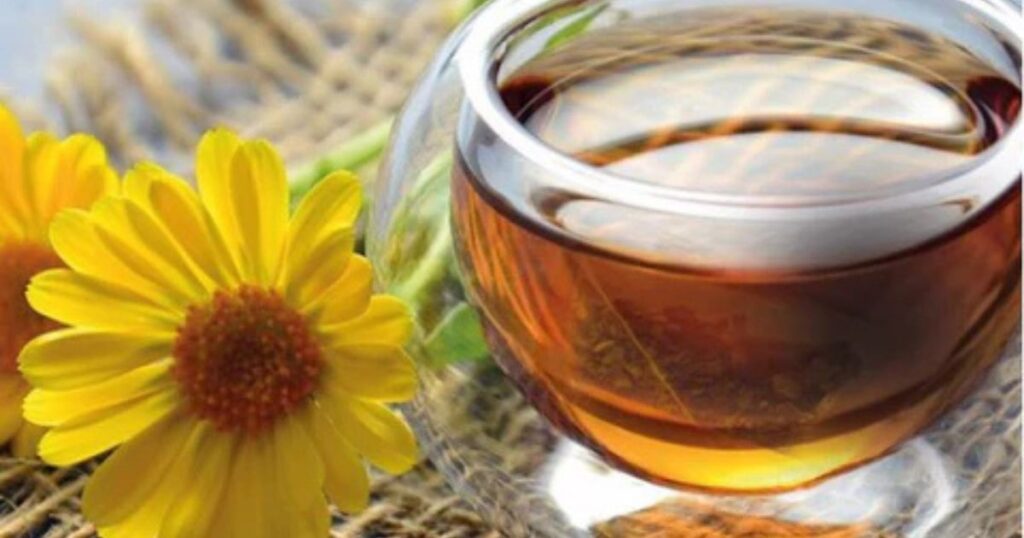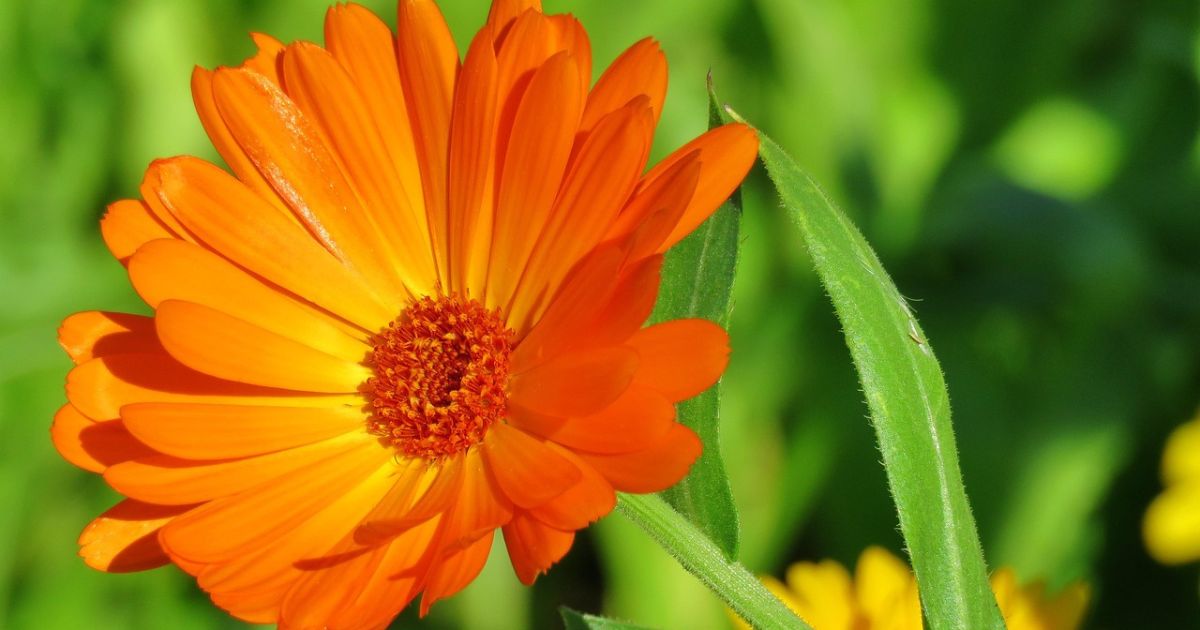Calendula officinalis, commonly known as pot marigold, is a vibrant, golden-orange flowering plant celebrated for its healing properties, culinary uses, and ornamental beauty. Native to Southern Europe and the Mediterranean region, Calendula has been cultivated for centuries in herb gardens, cottage landscapes, and medicinal plots. Today, it is cherished as both a natural remedy and a cheerful garden flower. In this comprehensive guide, we will explore everything you need to know about calendula officinalis—its history, health benefits, skincare and culinary applications, and a complete step-by-step guide on growing and harvesting it successfully.
What Is Calendula Officinalis?
Calendula officinalis, commonly known as pot marigold, is a vibrant flowering plant celebrated for both its ornamental beauty and medicinal properties. Belonging to the Asteraceae family, it produces bright yellow to orange blooms that thrive in gardens and herbal plots. Native to southern Europe but now grown worldwide, Calendula has long been valued in traditional medicine and skincare calendula plant remedies.
Its petals contain natural compounds with anti-inflammatory, antifungal, and antibacterial qualities, making it useful for soothing skin irritations, minor cuts, and burns. Often infused into oils, teas, and salves, Calendula is also used as a culinary garnish and an ingredient in herbal teas. Beyond its healing potential, it attracts pollinators, enhancing garden biodiversity. This versatile, easy-to-grow plant combines beauty, health benefits, and practical uses, making it a favourite among both gardeners and callendula herbalists.
A Brief History of Calendula
 Calendula, commonly known as marigold, has a rich history spanning centuries, valued for its vibrant flowers and versatile uses. Native to southern Europe, this hardy plant has been cultivated since ancient times, revered by the Egyptians, Greeks, and Romans for its medicinal, culinary, and ceremonial uses. Historically, it was used to soothe skin ailments, treat wounds, and add colour to calendula plants dishes.
Calendula, commonly known as marigold, has a rich history spanning centuries, valued for its vibrant flowers and versatile uses. Native to southern Europe, this hardy plant has been cultivated since ancient times, revered by the Egyptians, Greeks, and Romans for its medicinal, culinary, and ceremonial uses. Historically, it was used to soothe skin ailments, treat wounds, and add colour to calendula plants dishes.
Beyond practical uses, Calendula held symbolic significance, often representing warmth, protection, and healing. During the Middle Ages, it became a staple in European herb gardens, appreciated for its resilience and bright blooms. Over time, Calendula spread worldwide, embraced not only for its beauty but also for its role in traditional medicine and natural remedies. Today, it remains a symbol of wellness and what is calendula officinalis vitality.
Health and Medicinal Benefits of Calendula
Calendula, also known as Calendula officinalis or marigold, is a versatile herb prized for its remarkable health and medicinal properties. Rich in antioxidants, flavonoids, and essential oils, Calendula promotes overall wellness and supports the body’s natural healing processes. Its anti-inflammatory and antimicrobial properties make it effective for soothing skin irritations, minor wounds, and rashes, while also accelerating tissue calendula officinalis plant repair.
Calendula is commonly used in teas, tinctures, and topical ointments to relieve digestive discomfort, boost the immune system, and reduce inflammation. Additionally, it supports oral health, helps manage acne, and provides gentle relief from menstrual cramps. Regular use of Calendula, in herbal or cosmetic forms, can enhance both internal and external health, making it a trusted natural remedy for marigold calendula officinalis centuries.
Skin Healing and Protection
Skin Healing and Protection refers to the process of nurturing the skin to recover from damage while safeguarding it from future harm. This involves soothing irritated or inflamed areas, repairing wounds, and restoring the skin’s natural barrier. Products and practices for skin healing often include moisturizers, natural oils, antioxidants, and gentle cleansers that promote regeneration and prevent infection.
Protective measures, such as applying sunscreen, wearing protective clothing, and maintaining hydration, help shield the skin from environmental stressors like UV rays, pollution, and harsh weather. Together, healing and calendula officinalis seeds protection ensure healthier, resilient, and radiant skin.
Anti-Inflammatory Properties
Anti-inflammatory properties refer to the ability of certain substances, foods, or compounds to reduce inflammation in the body. Inflammation is the body’s natural response to injury or infection, but chronic inflammation can lead to various health issues, including arthritis, heart disease, and autoimmune disorders.
Natural anti-inflammatory agents, such as turmeric, ginger, omega-3 fatty acids, and certain herbs, work by inhibiting inflammatory pathways, reducing pain, and promoting healing. Regular consumption or use of these anti-inflammatory substances can support overall wellness, improve joint health, boost immunity, and contribute to long-term protection against inflammation-related calendula officinalis flower extract diseases.
Antimicrobial and Antifungal Effects
Antimicrobial and antifungal effects refer to the ability of certain substances to inhibit or destroy harmful microorganisms, including bacteria, fungi, and other pathogens. These effects are essential in medicine, agriculture, and personal care, helping prevent infections, promote wound healing, and protect crops from disease.
Natural compounds, such as essential oils, plant extracts, and some minerals, often exhibit antimicrobial and antifungal properties, making them valuable alternatives to synthetic chemicals. By targeting microbial growth and fungal activity, these agents contribute to health, hygiene, and overall safety in both human and environmental what is calendula applications.
Digestive Support
Digestive support focuses on maintaining a healthy gut and promoting efficient digestion. It involves a combination of balanced nutrition, probiotics, fibre-rich foods, and herbal supplements that help regulate bowel movements, reduce bloating, and enhance nutrient absorption. Supporting the digestive system can improve overall well-being, boost energy levels, and strengthen the immune system. Products or practices aimed at digestive support often target the balance of gut bacteria, soothe inflammation, and aid in the more effective breakdown of food. Prioritizing digestive health is essential for long-term vitality and comfort, calendula is marigold making it a cornerstone of a healthy lifestyle.
Immune System Boost
Calendula contains antioxidants that protect the body from oxidative stress and may enhance immune defence. Calendula mouth rinses are used to reduce gum inflammation, mouth ulcers, and sore throats due to their antibacterial and soothing properties.
Menstrual Relief
Herbalists use Calendula to regulate menstrual cycles and ease cramps thanks to its mild hormone-balancing pot marigold plants effects.
Calendula in Skincare and Beauty
 Calendula, also known as marigold, is celebrated in skincare and beauty for its soothing, healing, and rejuvenating properties. Rich in antioxidants, flavonoids, and essential oils, Calendula helps calm irritated skin, reduce redness, and promote natural healing, making it ideal for sensitive or inflamed skin. Its gentle yet effective anti-inflammatory and antimicrobial qualities make it a popular ingredient in creams, balms, and facial oils, supporting skin hydration and protection against environmental stressors.
Calendula, also known as marigold, is celebrated in skincare and beauty for its soothing, healing, and rejuvenating properties. Rich in antioxidants, flavonoids, and essential oils, Calendula helps calm irritated skin, reduce redness, and promote natural healing, making it ideal for sensitive or inflamed skin. Its gentle yet effective anti-inflammatory and antimicrobial qualities make it a popular ingredient in creams, balms, and facial oils, supporting skin hydration and protection against environmental stressors.
Beyond its therapeutic benefits, Calendula adds a natural touch of radiance and softness to the skin, enhancing overall complexion. From nourishing face masks to calming body lotions, this versatile flower blends traditional herbal wisdom with modern skincare, offering a natural solution for healthy, glowing, and youthful skin.
Culinary Uses of Calendula
Calendula flowers are edible and have a slightly peppery, tangy flavour. They add both beauty and nutrients to dishes.
- Salads: Sprinkle fresh petals for colour and nutrition.
- Teas: Brewed into herbal teas for digestive health and relaxation.
- Rice and soups: Used historically as “poor man’s saffron” to colour and flavour meals.
- Cakes and breads: Petals can be baked into bread, muffins, or cakes.
Calendula is not only ornamental but also a versatile herb that enriches both the plate and the body.
How to Grow Calendula Officinalis
Calendula officinalis, commonly known as pot marigold, is a vibrant, easy-to-grow flowering plant valued for its medicinal, culinary, and ornamental uses. Thriving in full sun, it prefers well-draining soil enriched with organic matter. Sow seeds directly into garden beds or containers in early spring, spacing them about 8–12 inches apart. Keep the soil consistently moist but avoid waterlogging. Calendula blooms quickly, producing cheerful, yellow to orange flowers that attract pollinators, such as bees and butterflies.
Regular deadheading encourages continuous flowering, while occasional fertilization supports healthy growth. Hardy and low-maintenance, this plant adapts well to various climates and can even reseed itself for the following season. With its soothing properties and ornamental charm, growing Calendula is both rewarding and practical for any garden.
Choosing the Right Location
Choosing the correct location is crucial for success, whether for a home, business, or garden. The ideal site strikes a balance between accessibility, safety, and environmental factors, ensuring both convenience and long-term satisfaction. When evaluating homes, consider proximity to work, schools, and amenities, while also assessing neighbourhood safety and future development plans.
Businesses thrive in areas with high visibility, foot traffic, and supportive infrastructure. Gardeners should assess sunlight, soil quality, drainage, and protection from harsh elements. Thoughtful consideration of these factors not only enhances comfort and productivity but also safeguards investments, making location a key foundation for sustainable growth and well-being.
Planting Calendula
Choosing the correct location is crucial for success, whether for a home, business, or garden. The ideal site strikes a balance between accessibility, safety, and environmental factors, ensuring both convenience and long-term satisfaction. When evaluating homes, consider proximity to work, schools, and amenities, while also assessing neighbourhood safety and future development plans. Businesses thrive in areas with high visibility, foot traffic, and supportive infrastructure.
Gardeners should assess sunlight, soil quality, drainage, and protection from harsh elements. Thoughtful consideration of these factors not only enhances comfort and productivity but also safeguards investments, making location a key foundation for sustainable growth and well-being.
Watering and Care
Proper watering and care are essential for healthy plant growth. Understanding each plant’s needs ensures they thrive, whether indoors or outdoors. Regular watering helps prevent stress, but overwatering can harm roots, so striking a balance is key. Complement watering with soil monitoring, sunlight exposure, and seasonal adjustments to ensure optimal plant health. Routine maintenance—such as pruning, fertilizing, and inspecting for pests—supports vigorous growth and vibrant blooms.
Choosing the right pot or garden bed, along with mulch or protective covers, helps retain moisture and regulate temperature. Consistent attention and tailored care routines transform ordinary plants into flourishing, resilient greenery, creating a lively and thriving garden environment.
Companion Planting
Companion planting is a strategic gardening method where different plants are grown together to benefit each other. By pairing compatible plants, gardeners can naturally improve growth, repel pests, attract pollinators, and enhance soil health. For example, planting basil near tomatoes can boost flavour and deter harmful insects, while marigolds can protect vegetables from nematodes.
This eco-friendly approach reduces the need for chemical fertilizers and pesticides, promotes biodiversity, and creates a healthier garden ecosystem. Whether in small home gardens or larger farms, companion planting is a simple yet effective technique that maximizes productivity, improves plant health, and encourages sustainable gardening practices.
Harvesting Calendula
Harvesting Calendula is a rewarding process that captures the vibrant beauty and healing properties of this versatile flower. Best harvested in the morning after the dew has dried, the bright orange and yellow blossoms are carefully picked to preserve the colour and potency of their petals. Regular harvesting encourages more blooms throughout the season, ensuring a continuous supply for culinary, medicinal, and cosmetic uses.
Once collected, petals can be dried for use in teas, salves, or tinctures, while fresh flowers can be used to add a bright touch to salads and dishes. Proper harvesting techniques help maintain plant health and prolong the flowering season, making Calendula a sustainable and valuable addition to any garden.
Common Problems and Solutions
- Powdery mildew: Avoid overcrowding and ensure good air circulation to prevent the disease from developing.
- Aphids and slugs: Control with natural remedies, such as neem oil or handpicking.
- Leggy growth: Pinch back stems to encourage bushier plants.
Varieties of Calendula
 Calendula, often referred to as pot marigold, offers a dazzling array of varieties that brighten gardens and promote wellness. From vibrant single blooms in golden yellow and fiery orange to lush double-flowered types, each variety brings unique charm. Compact dwarf varieties are well-suited for containers and small spaces, while taller types excel in borders and flower beds.
Calendula, often referred to as pot marigold, offers a dazzling array of varieties that brighten gardens and promote wellness. From vibrant single blooms in golden yellow and fiery orange to lush double-flowered types, each variety brings unique charm. Compact dwarf varieties are well-suited for containers and small spaces, while taller types excel in borders and flower beds.
Beyond their ornamental appeal, many Calendula varieties are prized for their soothing skin properties and culinary uses, with petals that add colour and mild flavour to dishes. Whether for decorative, therapeutic, or edible purposes, exploring Calendula varieties brings both beauty and versatility to any garden.
How to Make Calendula Remedies at Home
Learning how to make calendula remedies at home is an excellent way to harness the natural healing power of this vibrant, golden flower. Calendula officinalis is renowned for its soothing, anti-inflammatory, and antiseptic properties, making it an ideal choice for skincare, minor cuts and burns, rashes, and digestive support. By creating simple homemade remedies—such as infused oils, salves, balms, and teas—you can enjoy these benefits in a natural, chemical-free way.
Preparing calendula remedies at home allows you to control the ingredients, ensuring freshness and potency. Whether you’re a beginner or an experienced herbalist, following step-by-step methods makes it easy to craft effective and versatile remedies for everyday wellness. Embrace this hands-on approach to herbal care and experience the gentle, healing touch of Calendula in your home.
Calendula Tea
- Add 1–2 teaspoons of dried calendula petals to hot water.
- Steep for 10 minutes, strain, and enjoy.
- Helps with digestive issues and sore throats.
- Fill a jar with dried calendula flowers.
- Cover with olive oil or almond oil.
- Let it infuse for 4–6 weeks in a sunny window.
- Strain and store for use in skincare.
- Melt beeswax with calendula-infused oil.
- Pour into small tins or jars.
- Use for cuts, burns, dry skin, and rashes.
Calendula Bath Soak
- Add a handful of dried calendula flowers to a muslin bag.
- Drop into a warm bath for soothing relaxation.
Sustainability and Calendula
 Sustainability and Calendula are deeply connected, as this versatile flower embodies eco-friendly gardening and natural wellness practices. Calendula, often grown without the use of chemical fertilizers or pesticides, promotes soil health and supports biodiversity by attracting pollinators, such as bees and butterflies. Its low-maintenance cultivation reduces water usage, making it ideal for sustainable gardens. Beyond the garden, Calendula offers natural medicinal and cosmetic benefits, providing an alternative to synthetic products, which helps decrease environmental impact.
Sustainability and Calendula are deeply connected, as this versatile flower embodies eco-friendly gardening and natural wellness practices. Calendula, often grown without the use of chemical fertilizers or pesticides, promotes soil health and supports biodiversity by attracting pollinators, such as bees and butterflies. Its low-maintenance cultivation reduces water usage, making it ideal for sustainable gardens. Beyond the garden, Calendula offers natural medicinal and cosmetic benefits, providing an alternative to synthetic products, which helps decrease environmental impact.
Its edible petals also contribute to sustainable cooking, adding colour and nutrients to dishes. By integrating Calendula into gardens, skincare, and cuisine, individuals embrace a holistic approach to sustainability—cultivating harmony with nature, conserving resources, and fostering eco-conscious living while enjoying the beauty and versatility of this vibrant, golden flower.
Tips for Success with Calendula
Growing Calendula (Calendula officinalis), also known as pot marigold, can bring vibrant colour and natural benefits to your garden. To thrive, choose well-draining soil and a sunny location, as Calendula loves full sunlight. Regular watering is essential, but avoid waterlogging, which can harm roots. Deadheading spent flowers encourages continuous blooms and prolongs the flowering season. Calendula is relatively pest-resistant, but be aware of aphids and powdery mildew, and address them promptly.
Companion planting with vegetables like tomatoes and carrots can naturally repel pests. Harvest flowers in the morning for maximum potency, perfect for teas, salves, or culinary use. With consistent care, Calendula offers both beauty and practical uses, making it a rewarding addition to any garden.
Conclusion:
Calendula officinalis is far more than a pretty garden flower—it’s a versatile plant with centuries of history in healing, cooking, and everyday living. From soothing skin irritations and boosting immunity to brightening salads and enhancing the beauty of flower beds, the value of Calendula is undeniable.
Easy to grow, low-maintenance, and endlessly functional, Calendula is a must-have for gardeners, herbal enthusiasts, and anyone seeking a more natural lifestyle. By planting Calendula, you’re not just cultivating a flower—you’re growing a source of wellness, beauty, and tradition.
FAQ:
What is Calendula Officinalis?
Calendula officinalis, commonly known as pot marigold, is a vibrant flowering plant recognized for its medicinal and ornamental properties. It is native to southern Europe but is now widely cultivated throughout the world.
How often does Calendula Bloom?
Calendula typically blooms from late spring to early autumn. Deadheading spent flowers can prolong blooming.
Can Calendula Officinalis be used in Cooking?
Yes, the petals are edible and often used in salads, soups, or as a natural colourant in dishes. They are sometimes referred to as “poor man’s saffron.”
Is Calendula safe for Everyone?
Generally, Calendula is safe for most adults and children. However, individuals with allergies to plants in the Asteraceae family should avoid it. Pregnant or breastfeeding women should consult a healthcare provider before use.
How do I Harvest Calendula?
Harvest flowers when they are fully open, preferably in the morning after the dew has dried. For medicinal use, dry them in a cool, dark place.







